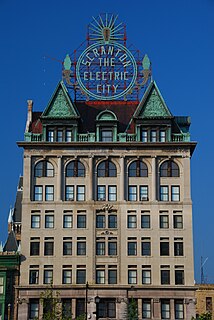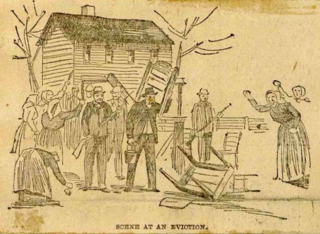
Scranton is the sixth-largest city in the Commonwealth of Pennsylvania. It is the county seat and largest city of Lackawanna County in Northeastern Pennsylvania's Wyoming Valley and hosts a federal court building for the United States District Court for the Middle District of Pennsylvania. With a population of 77,291, it is the largest city in the Scranton–Wilkes-Barre–Hazleton, PA Metropolitan Statistical Area, which has a population of about 570,000. The city is conventionally divided into 8 districts: North Scranton, Southside, Westside, the Hill Section, Central City, Minooka, East Mountain, and Green Ridge, though these areas do not have legal status.

Mount Pleasant is a borough in Westmoreland County, Pennsylvania, United States. It stands 45 miles (72 km) southeast of Pittsburgh. As of the 2010 census, the borough's population was 4,454.

South Greensburg is a borough in Westmoreland County, Pennsylvania, United States. The population was 2,117 at the 2010 census.

The United Mine Workers of America is a North American labor union best known for representing coal miners. Today, the Union also represents health care workers, truck drivers, manufacturing workers and public employees in the United States and Canada. Although its main focus has always been on workers and their rights, the UMW of today also advocates for better roads, schools, and universal health care. By 2014, coal mining had largely shifted to open pit mines in Wyoming, and there were only 60,000 active coal miners. The UMW was left with 35,000 members, of whom 20,000 were coal miners, chiefly in underground mines in Kentucky and West Virginia. However it was responsible for pensions and medical benefits for 40,000 retired miners, and for 50,000 spouses and dependents.

The Coal strike of 1902 was a strike by the United Mine Workers of America in the anthracite coalfields of eastern Pennsylvania. Miners struck for higher wages, shorter workdays, and the recognition of their union. The strike threatened to shut down the winter fuel supply to major American cities. At that time, residences were typically heated with anthracite or "hard" coal, which produces higher heat value and less smoke than "soft" or bituminous coal.

The Lattimer massacre was the violent deaths of at least 19 unarmed striking immigrant anthracite miners at the Lattimer mine near Hazleton, Pennsylvania, on September 10, 1897. The miners, mostly of Polish, Slovak, Lithuanian and German ethnicity, were shot and killed by a Luzerne County sheriff's posse. Scores more workers were wounded. The massacre was a turning point in the history of the United Mine Workers (UMW).
The Connellsville Coalfield is located in Fayette County and Westmoreland County, Pennsylvania, between the city of Latrobe and the small borough of Smithfield, and is sometimes known as the Connellsville Coke Field. This is because the section of the Pittsburgh coal seam here was famous as one of the finest metallurgical coals in the world. It is locally known as the Connellsville coal seam, but is actually a portion of the Pittsburgh seam.
The Westmoreland County coal strike of 1910–1911, or the Westmoreland coal miners' strike, was a strike by coal miners represented by the United Mine Workers of America. The strike is also known as the Slovak Strike because about 70 percent of the miners were Slovak immigrants. It began in Westmoreland County, Pennsylvania, on March 9, 1910, and ended on July 1, 1911. At its height, the strike encompassed 65 mines and 15,000 coal miners. Sixteen people were killed during the strike, nearly all of them striking miners or members of their families. The strike ended in defeat for the union.
John B. Rae was an American labor leader. He served as the president of the Knights of Labor Assembly 135, a coal miners' union. He and John McBride co-founded the United Mine Workers of America in 1890, and Rae served as the labor union's first president. Rae led national coal miners' strikes in 1890 and 1891, both of which the union lost. He chose not to run for re-election, and McBride won election as his successor.

Alfreton Hall is a country house in Alfreton, Derbyshire. It was at the heart of local social and industrial history in the county. The history of the estate goes back to Norman times, but by the 17th century it was owned by the Morewood family, who were linked to local industry, mainly in coal mining.

Whitsett is an unincorporated community in Fayette County, Pennsylvania, United States, about 30 miles (50 km) south of Pittsburgh population is around 200. It was founded in 1845 by Ralph C. Whitsett, Sr. He and his family built a large red brick house in 1873, which still stands today. The community is made up of mostly “company” houses that were built for workers that worked in a large coal mine located nearby, the mine was Banning #21. Most of the houses were ½ houses built to accommodate two families. The mine has been closed since 1954 and most of the houses have been renovated and turned into single-family dwellings.
United is located in Mount Pleasant Township, Westmoreland County, Pennsylvania. It is a community located near Norvelt, Pennsylvania.

Joseph Morewood Staniforth was a Welsh editorial cartoonist best known for his work in the Western Mail, Evening Express and Sunday weekly the News of the World. Staniforth has been described as "...the most important visual commentator on Welsh affairs ever to work in the country."
Mining in the United States has been active since the beginning of colonial times, but became a major industry in the 19th century with a number of new mineral discoveries causing a series of mining rushes. In 2015, the value of coal, metals, and industrial minerals mined in the United States was US $109.6 billion. 158,000 workers were directly employed by the mining industry.

Horning is a neighborhood in the borough of Baldwin in Allegheny County, Pennsylvania, United States. It was the residence of miners of the Pittsburgh Terminal Railroad and Coal Company #4 Mine, which had a racially integrated workforce, unusual in that era.

The Morewood massacre was an armed labor-union conflict in Morewood, Pennsylvania, in Westmoreland County, west of the present-day borough Mount Pleasant in 1891.
The 1927 Indiana bituminous strike was a strike by members of the United Mine Workers of America (UMWA) against local bituminous coal companies. Although the struggle raged throughout most of the nation's coal fields, its most serious impact was in western Pennsylvania, including Indiana County. The strike began on April 1, 1927, when almost 200,000 coal miners struck the coal mining companies operating in the Central Competitive Field, after the two sides could not reach an agreement on pay rates. The UMWA was attempting to retain pay raises gained in the contracts it had negotiated in 1922 and 1924, while management, stating that it was under economic pressure from competition with the West Virginia coal mines, was seeking wage reductions. The strike proved to be a disaster for the union, as by 1929, there were only 84,000 paying members of the union, down from 400,000 which belonged to the union in 1920.
The Pennsylvania AFL–CIO is a federation of labor unions in the U.S. state of Pennsylvania in the United States. It is an affiliate of the AFL-CIO. It was formed on June 9, 1960, by the merger of two predecessor bodies, the Pennsylvania Federation of Labor and the Pennsylvania Industrial Union Council. It can trace its history through its predecessor bodies to 1890.

The Mammoth Mine disaster or Frick Mine explosion occurred on January 27, 1891 just after 9:00 AM in the Mammoth No. 1 mine in Mount Pleasant Township, Westmoreland County, Pennsylvania. Newspapers reported that firedamp was ignited by a miner's oil lamp, resulting in the deaths of 109 men and boys. Most of the miners were not killed by the force of the explosion, but rather were suffocated by the effects of afterdamp.












